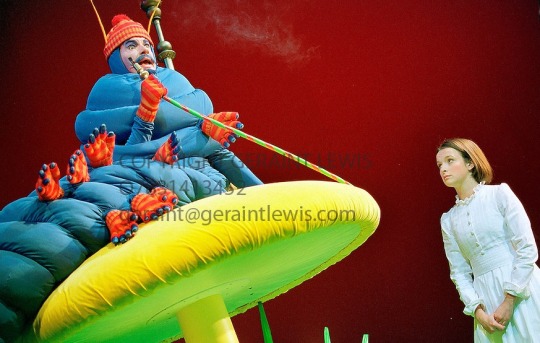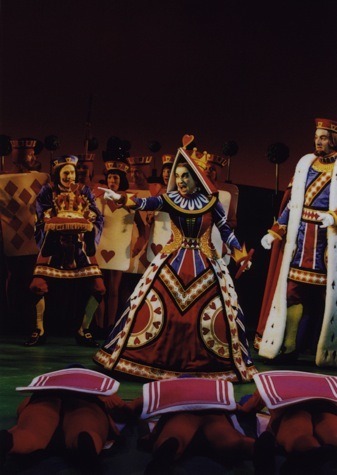
NOTE: This review uses photos from Photostage, clarevidalhall and Geraint Lewis, complete with watermarks. Please note that I cannot remove the watermarks as these are private property, and the photos belong to the owners. No copywrite infringement is intended.
(EDIT: As of 2025, I can say, I've read other play adaptations of Alice and this is by FAR the best one. Hands down, nothing comes close. I'm not sure why I didn't love this 100 percent on first read or watch. You can take that 4 star I gave this up to a 5 now. No, it REALLY is that good. Here's the licencing link worldwide. Yes, you CAN perform this in any theatre environment you want!)
With many thanks to @silvesterbotticelli.
A SMALL INTRODUCTORY NOTE
This review is of a non-commercial recording of the 2001 cast which is held in a private collection.The Original cast has its own successes and failings, and there are many differences between this production and that which is described in the published script. I will address the ending issue of the published script in the review, and I will also judge this production on its own merits.

BEGIN AT THE BEGINNING…
Adrian Mitchell’s Alice in Wonderland and Through the Looking-Glass had its World Premiere on the 29th of November 2001 at the Barbican Theatre in London. The recording that my review takes from was recorded on the 25th of February 2002, far ahead in to the show’s run.
Mitchell’s show was much derided at the time but has since grown a healthy afterlife in amateur and community productions. Upon seeing this recording, the show’s original critical response is baffling to me. No, the show is NOT perfect by any means, but two stars? Really?
The show begins with Dodgson, Duckworth, and the Liddells that fateful golden afternoon in Oxford. The girls clamour for a story, and Dodgson and co find shade under a tree. As he begins spinning his tale, the company freeze in time as Alice Liddell stands up and becomes fictional “Alice”. On seeing the white rabbit, she does what we know she will.
Unlike the published script, the act of Alice Liddell transforming into “Alice” is here better indicated, whereas in the published text it was only implied, here it is actively shown.
WONDERLAND
Alice’s fall down the rabbit hole is portrayed as a fall through a large hole which the audience look through, with wires attached to the actress. Quite an effective trick (you have to remember this was in a time pre video projections) especially with all the furniture and such spinning around with her. As I had read the published script I was dreading the 1st “new song” written for this version, which is “down, down, down”. Whilst on paper it sounds dreadful, in this production the tune and Company singing are beautiful, meaning it more than works (whether it would in other productions, minus this musical arrangement is another thing)
The hall of doors is sped through, with hardly anything from Alice’s identity crisis of the book remaining. The functions of drink me and eat me are also reversed for reasons unknown. Better is “How Doth the Little Crocodile” complete with adorable crocodile puppet. Awwww!
The mouse scene and caucus race are also handled very well, with the actors playing Dodgson, Duckworth, and other Liddell sisters returning to play their Wonderland counterparts. Unlike the book, Alice doesn’t insult the mouse through misunderstandings of the words “tale” and “tail”, she just yawns and the Mouse takes it as a slight on his honour! Moves the action on faster I guess?

The White Rabbit’s House scene isn't included in this version, which I can only guess due to being potentially too tricky to stage. The Caterpillar scene is a strong highlight with John Conroy’s delightfully impertinent Caterpillar sparring against Katherine Heath’s confused, quiet and well mannered Alice. Another highlight is “You are Old Father William” which is sung by a 2 man vaudeville act (they bustle in just before Alice recites it, convinced she’s stealing their act!) although I would note the instrumentation seems to fast in the chorus, rendering the punchlines hard to hear.
The Duchess’s kitchen scene felt too fast paced. I understand the scene is meant to be chaotic, but as its a not very popular part of the book, I felt some of the actors (particularly Fiona Dunn’s cook) were reciting lines as quickly as possible. The effect of the Cheshire cat in the oak tree was honestly not impressive. They just had the actress (Sarah Redmond) in a box in the tree looking down and occasionally grinning. However this is because of the theatrical constraints of the time and as such, I can’t really complain. Redmond’s Cheshire cat was fair but not overly memorable.

This is followed by possibly the best scene in the Wonderland adaptation. The Mad tea Party. Martin Turner’s March Hare and Chris Larner’s Hatter play off each other brilliantly, whilst Marilyn Cutts makes for a cutely confused dormouse. The overall impression of this tea party is one of deep hostility. The March Hare and Hatter keep looming over the table at Alice in a slightly sinister way, and Katherine Heath’s Alice keeps moving uncomfortably in her chair, slightly unnerved perhaps. When she says “I’ll never go there again…” you can sense she really means it.

The Queen’s garden and croquet scenes are played out as a great opportunity to feature everyone we’ve met already, as such these are monstrously large ensemble scenes, complete with puppet flamingos and the like. The Queen of Hearts is played by Liza Stadovy, who can’t seem to choose between Flora Robinson's 1972 depiction or Miranda Richardson’s 1999 depiction, so in the end opts for both at the same time. Its an odd mix…
This is unfortunately followed by the worst scene in the Wonderland adaptation, which is the Mock Turtle and Gryphon. I do not understand the actor’s decisions with these characters at all. Martyn Elis’s Gryphon shouts every line, whilst Paul Lenard’s Mock Turtle states everything in a dull voice. This is one scene which would be infinitely better in another production! Katherine Heath tries her best, but even she cannot save this dull, dull scene. Even worse is the Lobster Quadrille, which Terry Davies and Steven Warbeck decided to arrange as a flamenco dance. Why? I also don’t like the idea of Alice joining in the chorus of a song she’s not meant to know. Who decided that?
With that thankfully over the adaptation gets back on course in a spectacular trial scene featuring the entire cast. The whole ensemble gets to shine here, particularly John Hodgkinson’s King of Hearts, who is wonderfully weak, assertive and confused alternately! Halfway through instead of growing bigger for no reason Alice eats a tart which makes her grow and turns the whole court into shaky puppets. Liza Stadovy has a lot of fun with her now squeaky Queen of Hearts voice. Just like in the book, the cards shower Alice, who fitfully tries to beat them off. Still not worked out how this effect was achieved…
Alice awakens in an armchair in her drawing room, with both of her sisters looking worried (she’s just knocked over a house of cards from the table beside her in her sleep) however as the snow begins to tumble down, they suddenly don’t want to hear about Alice’s curious dream. Snow is more exciting apparently…
In the published script, Alice staggers into the scene, vaguely knocks over the card table and somehow becomes aware to the reality of things. In the published script, the audience is only told Wonderland was a dream in one line!
This production’s idea of actually seeing Alice awaken helps clear up any confusion.